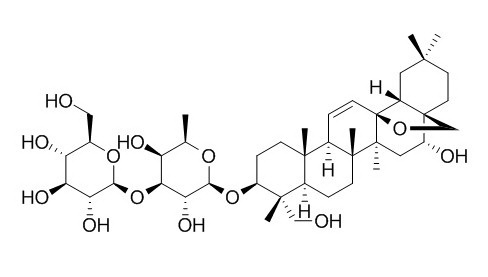Natural Products
Saikosaponin D
| Catalog No. | CFN99989 |  |
| CAS No. | 20874-52-6 | |
| Molecular Weight: | 780.99 | |
| Molecular Formula | C42H68O13 | |
| DBs | [PubChem]:274950965 [ChEMBL]: [PCIDB]:40182 |
Standard InChI:
InChI=1S/C42H68O13/c1-21-28(46)33(55-34-31(49)30(48)29(47)22(18-43)53-34)32(50)35(52-21)54-27-10-11-37(4)23(38(27,5)19-44)8-12-39(6)24(37)9-13-42-25-16-36(2,3)14-15-41(25,20-51-42)26(45)17-40(39,42)7/h9,13,21-35,43-50H,8,10-12,14-20H2,1-7H3/t21-,22-,23-,24-,25-,26-,27+,28+,29-,30+,31-,32-,33+,34-,35+,37+,38+,39-,40+,41-,42+/m1/s1
Biological Activity
SaikosaponinD (SSd) is a major triterpenoid saponin derivative from Radix bupleuri, which has been long used in Chinese traditional medicine for treatment of various inflammation-related diseases; it shows potent anti-inflammatory activity through inhibitory effects on NF-κB activation and thereby on iNOS, COX-2 and pro-inflammatory cytokines.[1]
Saikosaponin D attenuates CCl4-induced hepatic fibrosis in rats, which may be related to its effects of hepato-protective and anti-inflammation properties,the down-regulation of liver TNF-α, IL-6 and NF-κBp65 expression and the increased I-κBα activity in liver.[2]
Saikosaponin D is an agonist of the glucocorticoid receptor (GR), and it possesses neuroprotective effects in corticosterone-treated PC12 cells; SSD exhibits its anti-apoptotic effects via differential regulation of mitochondrial and nuclear GR translocation, partial reversal of mitochondrial dysfunction, inhibition of the mitochondrial apoptotic pathway, and selective activation of the GR-dependent survival pathway.[3]
Saikosaponin D is a novel autophagic inducer, can increase cytosolic calcium level via direct inhibition of sarcoplasmic/endoplasmic reticulum Ca(2+) ATPase pump, leading to autophagy induction through the activation of the Ca(2+)/calmodulin-dependent kinase kinase-AMP-activated protein kinase-mammalian target of rapamycin pathway, which has the potential of being developed into an anti-cancer agent for targeting apoptosis-resistant cancer cells.[4]
Product
References
[1] Lu C N, Yuan Z G, Zhang X L, et al. Int Immun Pharmaco, 2012, 14(1):121-126.
[2] Dang S S, Wang B F, Cheng Y A, et al. World J Gastroentero, 2007, 13(4):557-63.
[3] Li Z Y, Jiang Y M, Liu Y M, et al. Prog neuro-psychoph, 2014, 53(1448):80-89.
[4] Wong V K, Li T, Law B Y, et al. Cell Death Dis, 2012, 4(7):e720-e720.
[5] Liu L Z, Xiao-Jun J I, Bang-Qin Y A. China Pharmacy, 2014, 25(23):2147-2149.
Product Use Citation





